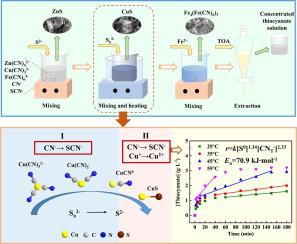Minerals Engineering ( IF 4.9 ) Pub Date : 2022-07-28 , DOI: 10.1016/j.mineng.2022.107760 Xiaoge Wang , Binchuan Li , Jianshe Chen , Shuang Cui , Kuiren Liu , Xiaocai He , Qing Han

|
This study develops an efficient technique to purify the highly concentrated cyanide-containing industrial wastewater by recovering the valuable components. Firstly, sodium sulfide, sodium polysulfide and ferrous sulfate were respectively used as the precipitating agents to retrieve zinc, copper and iron from wastewater stepwise. In the meantime, cyanide presented as free cyanide and copper–cyanide complexes were transformed into thiocyanate by polysulfide. Afterwards, the solvent extraction of thiocyanate was systematically conducted with trioctylamine (TOA) as the extraction agent and sodium hydroxide solution as the stripping agent. The results showed that the contents of zinc, copper and iron in the solution after precipitation were less than 1 mg·L−1. Focusing on the reaction between copper–cyanide complex and polysulfide, three stages were established for the first time. In the first stage, Cu(CN)32− was gradually converted to CuCN0 and thiocyanate was rapidly generated. In the second stage, in addition to the formation of thiocyanate, Cu(I) was oxidized by polysulfide and precipitated as CuS ultimately. With an apparent activation energy of 70.9 kJ∙mol−1, kinetic analysis of the second stage suggested a significant effect of temperature on the copper–cyanide complex conversion rate. The apparent reaction orders of zero-valent sulfur and cyanide was 1.34 and 2.33, respectively. After the extraction and stripping process, the extraction efficiency of thiocyanate was nearly 100 % and the concentration of it can be enriched to 125 g·L−1 in the stripping solution. TOA and thiocyanic acid formed an extraction complex in a 1:1 ratio. This approach achieves the simultaneous recovery of valuable metallic ions (zinc, copper and iron) and cyanide conversion under the alkaline condition, which provides a new idea for the treatment of highly concentrated cyanide-containing wastewater with a complicated composition.
中文翻译:

通过有价成分的逐步回收净化高浓度含氰废水
本研究开发了一种通过回收有价值的成分来净化高浓度含氰工业废水的有效技术。首先,分别以硫化钠、多硫化钠和硫酸亚铁为沉淀剂,逐步从废水中回收锌、铜和铁。同时,氰化物以游离氰化物的形式呈现,铜-氰化物配合物通过多硫化物转化为硫氰酸盐。随后,以三辛胺(TOA)为萃取剂,氢氧化钠溶液为反萃取剂,系统地进行了硫氰酸盐的溶剂萃取。结果表明,沉淀后溶液中锌、铜、铁的含量均小于1 mg·L -1. 首次围绕铜氰络合物与多硫化物的反应建立了三个阶段。在第一阶段,Cu(CN) 3 2-逐渐转化为CuCN 0并迅速生成硫氰酸盐。在第二阶段,除了硫氰酸盐的形成,Cu(I) 被多硫化物氧化并最终沉淀为 CuS。表观活化能为 70.9 kJ∙mol -1,第二阶段的动力学分析表明温度对铜氰化物络合物转化率有显着影响。零价硫和氰化物的表观反应级数分别为 1.34 和 2.33。经萃取反萃处理后,硫氰酸盐的萃取率接近100%,反萃液中硫氰酸盐的浓度可富集至125 g·L -1。TOA 和硫氰酸以 1:1 的比例形成萃取复合物。该方法在碱性条件下实现了有价值金属离子(锌、铜和铁)的同时回收和氰化物转化,为处理高浓度、成分复杂的含氰废水提供了新思路。









































 京公网安备 11010802027423号
京公网安备 11010802027423号